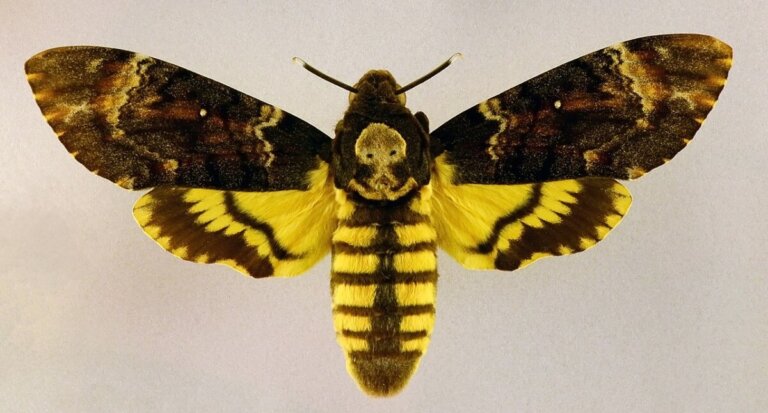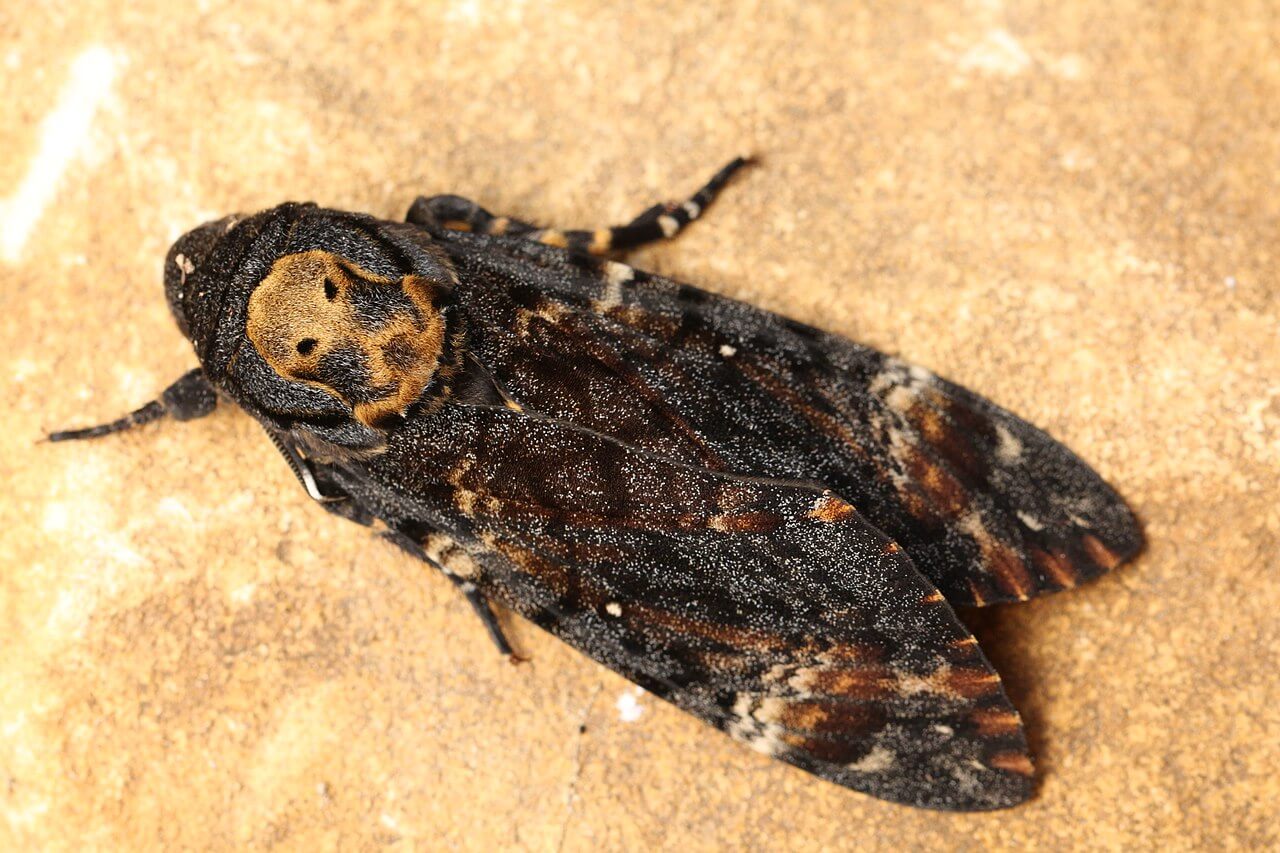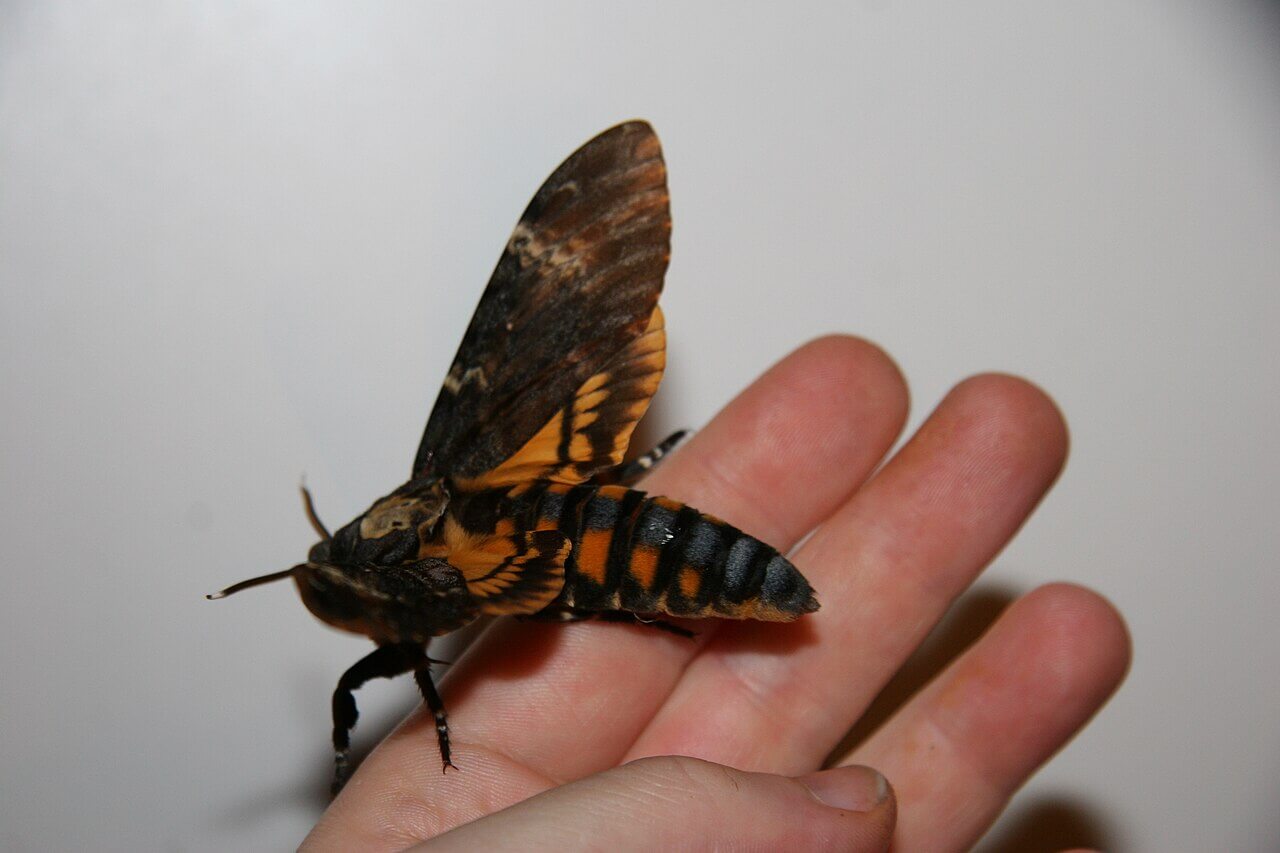Discover the Death's-Head Hawk Moth!

Have you ever heard of the death’s-head hawk moth? It’s a large moth with a distinctive mark on its back, which has been associated with many beliefs and superstitions of fear. It has been associated with many scary beliefs and superstitions. But for what reason?
In this article, we’ll explore this insect in depth, as well as learn about its diet and other curiosities about this bug that’s feared by so many.
What is the death’s-head hawk moth like?
The first thing you should know in order to recognize the death’s-head hawk moth is what it looks like. Roughly speaking, it’s a moth that measures between 3.5 and 4.75 inches long, with two antennae and wings that are yellow and black in color. It can also be found in a light or brown color.
However, what stands out the most is what’s on its thorax: A few black horizontal lines and a mark that looks very similar to a skull. This insect isn’t easy to see it during the day, as it’s a nocturnal insect.
Where does the death’s-head hawk moth come from?
The death’s-head hawk moth is a species from Africa. As a result of the storms that occur on that continent around June, it makes periodic migrations to the north (Europe and Eurasia), specifically from the countries in the northern region to the South Caucasus. It also often reaches the Canary Islands and northern Iran.
It’s common to find this moth in large cultivated areas, especially those with solanaceous plants, such as the following:
- Potatoes
- Tomatoes
- Belladonna
When it’s in its caterpillar stage, it usually feeds on the leaves of these plants, as its habitat is close to these types of plantations.
Where does the death’s-head hawk moth get its name?

As mentioned before, there are several factors and superstitions surrounding this insect that have led to its name. For example, it’s believed that its scientific name (Acherontia atropos) comes from ancient Greece, as Acheron is the river of pain in the Underworld, and Atropos is the name of one of the Greek deities of destiny who took the life of humans.
There are even those who have taken the death’s-head hawk moth and immortalized it in books of the horror genre. In 1946, the writer Edgar Allan Poe published a short story called The Sphinx, in Arthur’s Lady’s Home Magazine, where he talked about this insect. There, he stated that it terrified people and was the bearer of bad news.
Likewise, in the book Dracula, the author Bram Stoker also made reference to terrifying moths with the drawing of a skull, while in the film The Silence of the Lambs, this creature is associated with paranormal events and evil forces.
The moth was wonderful and terrible to see, its large brown-black wings tented like a cloak, and on its wide furry back, the signature device that has struck fear in men for as long as men have come upon it suddenly in their happy gardens. The domed skull, a skull that is both skull and face, watching from its dark eyes, the cheekbones, the zygomatic arch traced exquisitely beside the eyes. ‘Acherontia styx,’ Pilcher said. ‘It’s named for two rivers in Hell.’
In many villages, the inhabitants believe that this moth brings bad luck to the houses it enters or is seen as an omen of death.
Why does it emit a characteristic sound?
This species is known for the peculiar and strange sound it makes when it feels threatened or bothered. It’s generated by a process called stridulation, which is common in many species of moths and other insects, in which it rubs two parts of its body together.
This sound is the result of an active defense, which it uses to frighten or disorient potential predators, such as birds or other animals, that might want to feed on it.
“The Death’s-headed Sphinx has occasioned much terror among the vulgar, at times, by the melancholy kind of cry which it utters, and the insignia of death which it wears upon its corslet.”
In the case of Acherontia atropos, when it feels threatened, it spreads its wings, rubs them together, and emits a loud and unpleasant noise, which manages to drive away some predators.
Is it really dangerous for humans?

Despite what its name says, the death sphinx is harmless to humans. In general, moths don’t represent a major danger: They don’t transmit diseases, they don’t bite, and they’re not poisonous. On the contrary, they facilitate the pollination process of plants.
Moths often approach houses attracted by various things, including light. Scientists recommend keeping them away from homes, opening windows, and turning off light bulbs or lamps, as, being nocturnal animals, they’re attracted to indoor lighting.
Other curious facts about the “Death’s-headed Sphinx”
In Spain, these moths are frequently found in warm areas in the south or Valencia. They’ve also become common in Lugo, Asturias, and Vizcaya. In addition to this, there are a series of interesting facts about this species of nocturnal moths that we’ll tell you about below:
- It feeds on honey, fermented sap, and some flowers.
- In warm climates, it can reproduce in up to two generations.
- It flies upright, according to a study conducted by scientists.
- It’s considered to be the fastest moth on the planet, with the ability to fly up to 43 miles per hour.
- It’s common for this lepidopteran to sneak into bee hives to steal honey. However, bees rarely recognize it because it has the ability to hide its scent.
If you see the death’s-head hawk moth, don’t be afraid of it
Although the death’s-head hawk moth has been associated with different negative cultural manifestations, we want to remind you that it doesn’t pose any major danger to other animals or humans. If you see it during a walk in the countryside or if it arrives at your home, simply open a space for it to continue its nocturnal flight.
Cover image credit: Vassil/Wikimedia Commons.
Have you ever heard of the death’s-head hawk moth? It’s a large moth with a distinctive mark on its back, which has been associated with many beliefs and superstitions of fear. It has been associated with many scary beliefs and superstitions. But for what reason?
In this article, we’ll explore this insect in depth, as well as learn about its diet and other curiosities about this bug that’s feared by so many.
What is the death’s-head hawk moth like?
The first thing you should know in order to recognize the death’s-head hawk moth is what it looks like. Roughly speaking, it’s a moth that measures between 3.5 and 4.75 inches long, with two antennae and wings that are yellow and black in color. It can also be found in a light or brown color.
However, what stands out the most is what’s on its thorax: A few black horizontal lines and a mark that looks very similar to a skull. This insect isn’t easy to see it during the day, as it’s a nocturnal insect.
Where does the death’s-head hawk moth come from?
The death’s-head hawk moth is a species from Africa. As a result of the storms that occur on that continent around June, it makes periodic migrations to the north (Europe and Eurasia), specifically from the countries in the northern region to the South Caucasus. It also often reaches the Canary Islands and northern Iran.
It’s common to find this moth in large cultivated areas, especially those with solanaceous plants, such as the following:
- Potatoes
- Tomatoes
- Belladonna
When it’s in its caterpillar stage, it usually feeds on the leaves of these plants, as its habitat is close to these types of plantations.
Where does the death’s-head hawk moth get its name?

As mentioned before, there are several factors and superstitions surrounding this insect that have led to its name. For example, it’s believed that its scientific name (Acherontia atropos) comes from ancient Greece, as Acheron is the river of pain in the Underworld, and Atropos is the name of one of the Greek deities of destiny who took the life of humans.
There are even those who have taken the death’s-head hawk moth and immortalized it in books of the horror genre. In 1946, the writer Edgar Allan Poe published a short story called The Sphinx, in Arthur’s Lady’s Home Magazine, where he talked about this insect. There, he stated that it terrified people and was the bearer of bad news.
Likewise, in the book Dracula, the author Bram Stoker also made reference to terrifying moths with the drawing of a skull, while in the film The Silence of the Lambs, this creature is associated with paranormal events and evil forces.
The moth was wonderful and terrible to see, its large brown-black wings tented like a cloak, and on its wide furry back, the signature device that has struck fear in men for as long as men have come upon it suddenly in their happy gardens. The domed skull, a skull that is both skull and face, watching from its dark eyes, the cheekbones, the zygomatic arch traced exquisitely beside the eyes. ‘Acherontia styx,’ Pilcher said. ‘It’s named for two rivers in Hell.’
In many villages, the inhabitants believe that this moth brings bad luck to the houses it enters or is seen as an omen of death.
Why does it emit a characteristic sound?
This species is known for the peculiar and strange sound it makes when it feels threatened or bothered. It’s generated by a process called stridulation, which is common in many species of moths and other insects, in which it rubs two parts of its body together.
This sound is the result of an active defense, which it uses to frighten or disorient potential predators, such as birds or other animals, that might want to feed on it.
“The Death’s-headed Sphinx has occasioned much terror among the vulgar, at times, by the melancholy kind of cry which it utters, and the insignia of death which it wears upon its corslet.”
In the case of Acherontia atropos, when it feels threatened, it spreads its wings, rubs them together, and emits a loud and unpleasant noise, which manages to drive away some predators.
Is it really dangerous for humans?

Despite what its name says, the death sphinx is harmless to humans. In general, moths don’t represent a major danger: They don’t transmit diseases, they don’t bite, and they’re not poisonous. On the contrary, they facilitate the pollination process of plants.
Moths often approach houses attracted by various things, including light. Scientists recommend keeping them away from homes, opening windows, and turning off light bulbs or lamps, as, being nocturnal animals, they’re attracted to indoor lighting.
Other curious facts about the “Death’s-headed Sphinx”
In Spain, these moths are frequently found in warm areas in the south or Valencia. They’ve also become common in Lugo, Asturias, and Vizcaya. In addition to this, there are a series of interesting facts about this species of nocturnal moths that we’ll tell you about below:
- It feeds on honey, fermented sap, and some flowers.
- In warm climates, it can reproduce in up to two generations.
- It flies upright, according to a study conducted by scientists.
- It’s considered to be the fastest moth on the planet, with the ability to fly up to 43 miles per hour.
- It’s common for this lepidopteran to sneak into bee hives to steal honey. However, bees rarely recognize it because it has the ability to hide its scent.
If you see the death’s-head hawk moth, don’t be afraid of it
Although the death’s-head hawk moth has been associated with different negative cultural manifestations, we want to remind you that it doesn’t pose any major danger to other animals or humans. If you see it during a walk in the countryside or if it arrives at your home, simply open a space for it to continue its nocturnal flight.
Cover image credit: Vassil/Wikimedia Commons.
All cited sources were thoroughly reviewed by our team to ensure their quality, reliability, currency, and validity. The bibliography of this article was considered reliable and of academic or scientific accuracy.
Ría de Noia. (29 de septiembre de 2019). Esfinge calavera Mariposa de la muerte (Acherontia atropos). [Archivo de Vídeo]. Youtube. https://youtu.be/D36xnMVSog4?si=VuJqfE53Z4_jwEPm
This text is provided for informational purposes only and does not replace consultation with a professional. If in doubt, consult your specialist.








